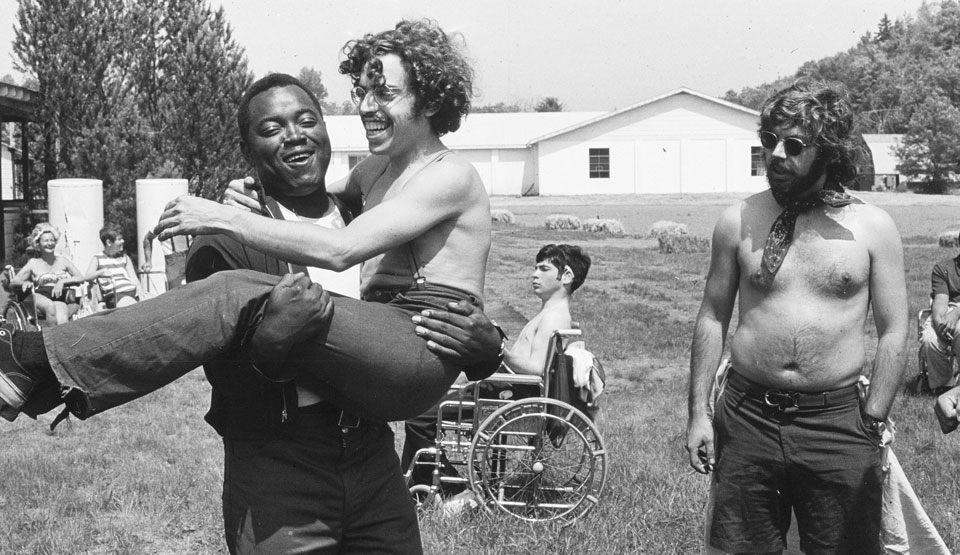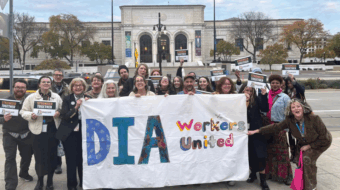
The landmark Americans with Disabilities Act is celebrating its 30th birthday. But the moment also calls for celebrating the movement that birthed it. Winning the ADA, legislation on a par with the Civil Rights Act of 1965, was the culmination of years of struggle, extraordinary courage, and perseverance of the disability community and its allies.
However, despite huge steps forward, 65 million Americans with disabilities still confront stigma, marginalization, and discrimination. They face additional discrimination based on race, gender, and sexual identity, and full enforcement of federal law, including voting rights, is still a daily struggle.
Moreover, people with disabilities are being infected and dying at disproportionate rates from Covid-19, leaving thousands of new disabled and chronically ill people. The GOP Heals Act shields companies and institutions from liability but allows discrimination and violations of safety protections for disabled people. US Senator Tammy Duckworth (D-Ill.), a disabled veteran, called the GOP proposal, “an outright assault on the disability community” that would gut the ADA.
Every gain is under assault by Trump, the GOP, and extreme right. Defeating Covid-19, addressing the economic depression, and defending and expanding disability rights and their enforcement, make the 2020 elections a critical battlefield.
Camp Jened – a little paradise
The inspiring Netflix documentary, Crip Camp: A Disability Revolution, captures a critical story in winning the ADA. The film, winner of the Sundance Award, is directed by Jim LeBrecht, who appears in the documentary, and Nicole Newnham, with Sara Bolder as the producer. Barack and Michelle Obama and their Higher Ground Production Company, are executive producers.
Crip Camp is a story in two parts. In the first, viewers share 1971 at a summer camp for disabled youngsters in the Catskills called Camp Jened. A documentary film-making collective, People’s Video Theater, was on hand and captured some priceless interactions. The film sat in storage for 45 years until it was finally digitized and what a treasure!
Here, Jened campers can feel fully human, without stigma and marginalization. It is also a time of discovery, sexual awakening, and teen angst. We experience campers’ sheer joy when participating in video production, baseball, getting high, having their first kiss, and horsing around.
But the experience is also empowering. In something like a collective awakening, campers learn each other’s stories, share similar experiences, and gain solidarity. Many develop lifelong bonds that play an essential role in disability rights history, as we see later.
One camp counselor is Judy Heumann, who stands out for how she respects and involves the campers. The film follows Heumann, disabled by polio at 18 months old, as she becomes one of the most prominent disability rights leaders in U.S. history and internationally.
The second part of the documentary tells the story of the disability rights movement of the 1970s-1990s, and the role of Heumann and other Jened campers, that culminates in ADA passage and development of a global movement.
Heumann and others found Disabled in Action, which files a discrimination lawsuit against the New York City Department of Education and fights for deinstitutionalization. One of the still shocking scenes is Willowbrook State School on Staten Island, which warehoused thousands of disabled people in deplorable conditions until the 1980s. It is there that the notorious experiments on the disabled, injecting them with the Hepatitis B virus, were carried out.
Heumann also fearlessly leads the first protest demanding public transit access as demonstrators snarl traffic in Midtown Manhattan with their wheelchairs.
The film shifts to Berkeley, California, at the time a radical center of disability rights organizing. Ed Roberts established the first Center for Independent Living there in 1972. Today, over 400 such centers are run by and for people with disabilities.
The fight to enforce Section 504 regulations of the Rehabilitation Act of 1972 is a critical turning point. Section 504 prohibits discrimination based on disability in federal agencies’ programs in language taken from the Civil Rights Act. The Carter Administration and HHS Secretary Joseph Califano Jr. are contemplating gutting the regulations.
Disability rights activists occupy HHS offices to block the action. The 28-day San Francisco sit-in becomes the most prolonged occupation of a federal facility in U.S. history. Enduring incredible hardships, the occupiers gain widespread community support. Allies pay for twenty-five protesters, led by Heumann, to fly to Washington, D.C., to confront Carter and Califano. The movement finally forces the Carter administration to embrace the regulations.
But as LeBrecht says, “it was a continual struggle to enforce 504.” Even as accessibility to public transit and buildings expands, employers still discriminate, and the law doesn’t cover the private sector. With Reagan’s election in 1980, disability rights and labor and civil rights come under renewed assault.
The disabled community realizes the need for a comprehensive civil rights law that guarantees disability rights. They lead the fight for the ADA’s passage, capped by one of the most stirring scenes imaginable—disabled activists pulling themselves up the Capitol steps in what became known as the “Capitol Crawl.”
Finally, with tremendous public support, the ADA is passed by Congress and signed by Pres. George H.W. Bush in 1990 despite opposition from corporations who saw the regulations as costly and cutting into their profits.
The fight against stigma
The fight for disabled people’s rights, and against stigma, institutionalization, and segregation stretches back hundreds of years. In the U.S. the eugenics movement led to the forced sterilization of 65,000 people, including disabled, people living in poverty, and African American and Native American women.
The Nazi’s were so impressed with California’s eugenics practices they adopted them, gassing 250,000 disabled Germans. Among those were thousands whose only “disability” was being the equivalent of two years behind the norm in reading and math level abilities.
The long fight for equal rights includes the establishment of Gallaudet University in 1864, the advocacy of Louis Braille, Helen Keller, the protests of returning disabled war veterans, and demands to end discrimination in the WPA and New Deal programs.
But it was the Civil Rights movement that inspired the modern-day disability rights movement and breakthroughs that followed, as it inspired movements for women’s, Latino, and Native American equality, and environmental justice.
The disability rights movement drew from the Supreme Court’s Brown v Board ruling that ended separate and unequal education. As Heumann says in a decisive exchange with an HHS bureaucrat during the HHS sit-in, “Whether there was a Section 504, there was a Brown v Board of Education. The harassment, the lack of equity, that has been provided for disabled individuals, and that is even being discussed by the administration is so intolerable I can’t quite put it into words. I can tell you, every time you raise issues of separate but equal the outrage of disabled individuals across this country is going to continue.”
‘Nothing about us without us’
The most meaningful way to observe the ADA’s 30th anniversary is to renew the fight for fulfilling its four basic premises: equal opportunity, full participation, independent living, and economic self-sufficiency.
“The ADA was a wonderful achievement,” said Denise Sherer Jacobson in the documentary. “But it was only a tiny tip of the iceberg. You can pass a law but until you change society’s attitudes that law won’t mean much.”
Despite the ADA gains, a system of separate and unequal rights for disabled people remains. Defending each achievement against constant efforts to roll back, and gut funding and enforcement is also a responsibility of the entire democratic movement because an injury to one is an injury to all.
When the horrific conditions that existed in places like Willowbrook were ended, in some states those institutions were replaced with neighborhood group homes and day treatment centers staffed by dedicated people. In subsequent years many of those were bought up and taken over by profiteers in the health care industry with no real concern for the needs of the residents and staff. They fought staff who attempted to unionize so they could protect both themselves and the disabled residents, so the struggle today is to improve deteriorating conditions in those new institutions. Profiteering health care companies have little regard for the disabled, as they have little regard for the entire population.
Since 2017, Trump, who famously mocked a disabled reporter, and the GOP have sought to undermine the ADA’s key provisions and defund it, along with the repeal of Obamacare, Medicaid, Medicare, and Social Security Disability Insurance.
But there is no quit among the disabled community and its allies to protect and expand rights. The 2020 elections offer a vital opportunity to make further advances. Voters with disabilities comprise 18% of the electorate and place a lot of importance on disabled issues.
During the recent Democratic Primaries, candidates offered plans to protect and build on the ADA, mostly agreeing to end the sub-minimum wage, fully fund IDEA guaranteeing special education services and expand access.
Elizabeth Warren presented what many consider the “most advanced platform.” Her proposal, drawn up in collaboration with disability rights advocates, begins by establishing a National Office of Disability Coordination. The plan addresses intersecting issues of economic, racial, gender, sexual identity, and environmental justice. “All policy issues are disability policy issues,” said Warren.
After much delay, Democratic Party presumptive nominee Joe Biden introduced his plan in late May. While not as advanced as Warren’s or Sen. Bernie Sanders’s plans, it was nonetheless welcomed by disabled activists as “an important start.”
As so, the fight for full equality for people with disabilities continues.










